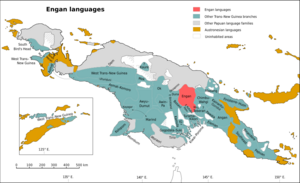Engan languages
Topic: Social
 From HandWiki - Reading time: 5 min
From HandWiki - Reading time: 5 min
| Engan | |
|---|---|
| Enga – Southern Highlands | |
| Geographic distribution | New Guinea |
| Linguistic classification | Northeast New Guinea and/or Trans–New Guinea?
|
| Subdivisions |
|
| Glottolog | enga1254[1] |
 Map: The Engan languages of New Guinea
The Engan languages
Trans–New Guinea languages
Other Papuan languages
Austronesian languages
Uninhabited | |
The Engan, or more precisely Enga – Southern Highland, languages are a small family of Papuan languages of the highlands of Papua New Guinea. The two branches of the family are rather distantly related, but were connected by Franklin and Voorhoeve (1973).[2]
Name
The name "Engan" is often restricted to the northern branch of the family, to those languages transparently related to Enga, but also sometimes to the family as a whole.
Languages
The languages fall into three quite distinct branches: Engan proper, Huli, and Southern Highlands:
- North Engan (Engan proper): Enga–Kyaka–Lembena, Ipili, Bisorio (Nete, Iniai)
- South Engan (Kewa–Huli)
- Huli
- Southern Highlands: Angal (Mendi), Kewa; Samberigi (Sau)
Classification
The Engan family constitutes a branch of the Trans–New Guinea languages in the classification of Malcolm Ross, but the evidence for this is weak.
There are a considerable number of resemblances with Wiru. Borrowing has not been ruled out as the reason for this, though the pronouns are similar as well.
Proto-language
Phonemes
Usher (2020) reconstructs the consonant inventory as follows:[3]
*m *n *p *t *k *mb *nd *ŋg *w *l *j
Vowels are *i *e *a *o *u.
Pronouns
Pronouns are easy to reconstruct for the northern and southern branches, but much more difficult for Engan as a whole. Ross (2005) has the following for the singular, Wiru has been added for comparison:
pEngan N Engan S Engan Wiru 1 **nə *na-ba *ní no (gen. anu) 2 **ne-ke *ne-ba *ne-ke ne (gen. ne-ke) 3 ? *ba *[n]i-bu one
Usher (2020) has not yet published reconstruction of Engan as a whole, but has done Engan proper:[4]
Engan proper sg du pl 1 *na(-mba) *nali(-mba) *nani(-ma) 2 *ni(-mba) 3 *[e]-mba
Vocabulary
Some lexical reconstructions of Proto-Trans Enga (Proto-Engan) by Usher (2020) are:[3]
gloss Proto-Trans-Enga Proto-Southern Highlands Huli name *ŋge *[i]mbi mi-ni fire/tree *ita *ti iɾa moon *kana *eke, *jumba ege four *tumenda *mala ma- path *kaita *pota haɾiga stand *kata *ka ha cassowary *laima *jati jaɾi skin *jan[o/u] *joŋgale doŋgo-ne
Evolution
The Enga-Kewa-Huli reflexes of proto-Trans-New Guinea (pTNG) etyma, if Engan languages are indeed members of the Trans-New Guinea family, are:[5]
Enga:
- mona ‘heart’ < *mundun
- yaka ‘bird’ < *yaka(i)
- lyaŋa ‘ashes’ < *la(ŋ,k)a
- ŋaŋa ‘baby < *ŋaŋ(a)
- (m)ama ‘mother’ < *am(a,i)
- kuri ‘bone’ < *kondaC
- kare ‘ear’ < *kand(e,i)k(V]
- ne- ‘eat’ < *na
- apa(ne) ‘father’ < *apa
- iti ‘hair’ < *iti[C]
- endo ‘fire’ < *kend(o,u)p
- lema ‘louse’ < *niman
- kana ‘moon’ < *takVn[V]
- mana ‘instructions’ < *mana
- kitama ‘morning’ < *k(i,u)tuma
- kumi- ‘die’ < *kumV-
- re- ‘speak’ < *nde-
- maa ‘taro’ < *mV
- ita ‘tree’ < *inda
Huli:
- ega ‘bird’ < *yaka(i)
- na- ‘eat’ < *na-
- aba ‘father’ < *apa
- iri ‘hair’ < *iti[C]
- ira ‘tree’ < *inda
- ma ‘taro’ < *mV
Kewa:
- ama ‘mother’ < *am(a,i)
- ibi ‘name’ < *imbi
- iri ‘hair’ < *iti[C]
- uni ‘bone’ < *kwanjaC
- apu ‘tail’ < *a(mb,m)u
- lema ‘louse’ < *niman
- oma ‘die’ < *kumV-
- reka- ‘stand’ < *t(a,e)kV-
- la- ‘talk’ < *nde-
- maa ‘taro’ < *mV
- yaa ‘bird’ < *yaka(i)
Mendi:
- am ‘mother’ < *am(a,i)
- ap ‘father’ < *apa
- mbi ‘name’ < *imbi
- ome- ‘die’ < *kumV-
Vocabulary
Basic vocabulary of Enga and Kewa from William A. Foley (1986):[6]
gloss Enga Kewa ‘two’ rama laapo ‘man’ akari ali ‘water’ ipa ipa ‘fire’ ita repona ‘tree’ ita are ‘leaf’ yoko yo ‘root’ pingi pitaa ‘house’ ada ada ‘breast’ adu adu ‘tooth’ nege agaa ‘bone’ kori kuli ‘ear’ kare kale ‘hair’ iti iri ‘leg’ kape aa ‘blood’ kupapu kupaa ‘hand’ ruma ki ‘egg’ kapa yaa apaa ‘sun’ nita nare ‘axe’ patama rai ‘netbag’ nuu nu ‘eat’ ne- na- ‘die’ kumi- koma- ‘say’ re- la- ‘give’ mai-/gi- gi- ‘big’ adake adaa
References
- ↑ Hammarström, Harald; Forkel, Robert; Haspelmath, Martin, eds (2017). "Enga–Kewa–Huli". Glottolog 3.0. Jena, Germany: Max Planck Institute for the Science of Human History. http://glottolog.org/resource/languoid/id/enga1254.
- ↑ Karl J. Franklin and C. L. Voorhoeve. 1973. Languages near the intersection of the Gulf, Southern Highlands and Western Districts. In Karl J. Franklin (ed.), The linguistic situation in the Gulf District and adjacent areas, Papua New Guinea, 149-186. Canberra: Research School of Pacific and Asian Studies, Australian National University.
- ↑ 3.0 3.1 "New Guinea World, Enga--Southern Highlands". https://sites.google.com/site/newguineaworld/families/enga-southern-highlands.
- ↑ New Guinea World, Trans-Enga
- ↑ Pawley, Andrew; Hammarström, Harald (2018). "The Trans New Guinea family". in Palmer, Bill. The Languages and Linguistics of the New Guinea Area: A Comprehensive Guide. The World of Linguistics. 4. Berlin: De Gruyter Mouton. pp. 21–196. ISBN 978-3-11-028642-7.
- ↑ Foley, William A. (1986). The Papuan Languages of New Guinea. Cambridge: Cambridge University Press. ISBN:0-521-28621-2.
- Ross, Malcolm (2005). "Pronouns as a preliminary diagnostic for grouping Papuan languages". in Andrew Pawley. Papuan pasts: cultural, linguistic and biological histories of Papuan-speaking peoples. Canberra: Pacific Linguistics. pp. 15–66. ISBN 0858835622. OCLC 67292782.
Further reading
- Ross, Malcolm. 2014. Proto-Engan. TransNewGuinea.org.
External links
- Timothy Usher, New Guinea World, Enga – Southern Highlands
- (ibid.) Trans-Enga
 |
 KSF
KSF